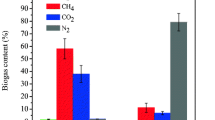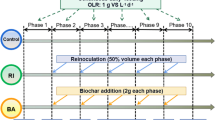Abstract
Acidogenic reactors commonly operated at short hydraulic retention times (HRT) are liable to cause low chemical oxygen demand (COD) removal and acidogenic efficiency especially under fluctuating feed. Granular sludge as an efficient form for anaerobic microbial community to resist shocks in methanogenic reactors has been widely investigated, which however was less focused in acidogenic reactors. Adding Fe0 in an acidogenic reactor with propionate as the substrate operated at HRT of 2 h was found to enhance the propionate decomposition and sludge granulation in this study. When increasing the organic load and decreasing pH in the feed, the propionate conversion and COD removal in the reactor with Fe0 were higher than those in the control reactor. The sludge granulation was well developed in this reactor. Fe0 advanced the growth of homoacetogenic bacteria that consumed the hydrogen produced in acetification of propionate. The propionate-oxidizing bacteria and homoacetogenic bacteria grew together in the sludge to accelerate hydrogen transfer, which was an important reason for the enhanced propionate decomposition and sludge granulation in the acidogenesis.




Similar content being viewed by others
References
APHA (2005) Standard methods for the examination of water and wastewater, 21st edn. American Public Health Association, Washington, DC
Cammarota MC, Sant’Anna GL (1998) Metabolic blocking of exopolysaccharides synthesis: effects on microbial adhesion and biofilm accumulation. Biotechnol Lett 20:1–4
Fang HHP, Yu HQ (2000) Effect of HRT on mesophilic acidogenesis of dairy wastewater. J Environ Eng–ASCE 126:1145–1148
Frolund B, Palmgren R, Keiding K, Nielsen PH (1996) Extraction of extracellular polymers from activated sludge using a cation exchange resin. Water Res 30:1749–1758
Fukuzaki S, Nishio N, Shobayashi M, Nagai S (1990) Inhibition of the fermentation of propionate to methane by hydrogen, acetate, and propionate. Appl Environ Microbiol 56:719–723
Guerrero L, Omil F, Mendez R, Lema JM (1999) Anaerobic hydrolysis and acidogenesis of wastewaters from food industries with high content of organic solids and protein. Water Res 33:3281–3290
Hulshoff Pol LW, de Castro Lopes SI, Lettinga G, Lens PNL (2004) Anaerobic sludge granulation. Water Res 38:1376–1389
Li JZ, Ban QY, Zhang LG, Jha AK (2012) Syntrophic propionate degradation in anaerobic digestion: a review. Int J Agric Biol 14:843–850
Liu Y, Xu HL, Yang SF, Tay JH (2003) Mechanisms and models for anaerobic granulation in upflow anaerobic sludge blanket reactor. Water Res 37:667–673
Liu YW, Zhang YB, Quan X, Chen S, Zhao HM (2011) Applying an electric field in a built-in zero valent iron-anaerobic reactor for enhancement of sludge granulation. Water Res 45:1258–1266
Liu YW, Zhang YB, Quan X, Li Y, Zhao ZQ, Meng XS, Chen S (2012) Optimization of anaerobic acidogenesis by adding Fe0 powder to enhance anaerobic wastewater treatment. Chem Eng J 192:179–185
Lovley DR (2011) Reach out and touch someone: potential impact of DIET (direct interspecies energy transfer) on anaerobic biogeochemistry, bioremediation, and bioenergy. Rev Environ Sci Biotechnol 10:101–105
Lowry OH, Rosebrough NJ, Farr AL, Randall RJ (1951) Protein measurement with the folin phenol reagent. J Biol Chem 193:265–275
Lu L, Xing DF, Liu BF, Ren NQ (2012) Enhanced hydrogen production from waste activated sludge by cascade utilization of organic matter in microbial electrolysis cells. Water Res 46:1015–1026
McCarty PL, Smith DP (1986) Anaerobic wastewater treatment. Environ Sci Technol 20:1200–1206
Meng XS, Zhang YB, Li Q, Quan X (2013) Adding Fe0 powder to enhance the anaerobic conversion of propionate to acetate. Biochem Eng J 73:80–85
Narihiro T, Terada T, Kikuchi K, Iguchi A, Ikeda M, Yamauchi T, Shiraishi K, Kamagata Y, Nakamura K, Sekiguchi Y (2009) Comparative analysis of bacterial and archaeal communities in methanogenic sludge granules from upflow anaerobic sludge blanket reactors treating various food-processing, high-strength organic wastewaters. Microbes Environ 24:88–96
Riazema A, Boone M, Vanknippenberg K, Lettinga G (1994) Bactericidal effect of long chain fatty acids in anaerobic digestion. Water Environ Res 1:40–49
Rudd T, Sterritt RM, Lester JN (1984) Complexation of heavy metals by extracellular polymers in the activated sludge process. J Water Pollut Control Fed 56:1260–1268
Ryan P, Forbes C, Colleran E (2008) Investigation of the diversity of homoacetogenic bacteria in mesophilic and thermophilic anaerobic sludges using the formyltetrahydrofolate synthetase gene. Water Sci Technol 57:675–680
Sbarciog M, Loccufier M, Noldus E (2010) Determination of appropriate operating strategies for anaerobic digestion systems. Biochem Eng J 51:180–188
Schmidt JE, Ahring BK (1996) Granular sludge formation in upflow anaerobic sludge blanket (UASB) reactors. Biotech Bioeng 49:229–246
Sekiguchi Y, Kamagata Y, Nakamura K, Ohashi A, Harada H (1998) Fluorescence in situ hybridization using 16S rRNA-targeted oligonucleotides reveals localization of methanogens and selected uncultured bacteria in mesophilic and thermophilic sludge granules. Appl Environ Microbiol 65:1280–1288
Shanmugam SR, Chaganti SR, Lalman JA, Heath DD (2014) Statistical optimization of conditions for minimum H2 consumption in mixed anaerobic cultures: effect on homoacetogenesis and methanogenesis. Int J Hydrogen Eenerg 39:15433–15445
Shen CF, Kosaric N, Blaszczyk R (1993) The effect of selected heavy-metals (Ni, Co and Fe) on anaerobic granules and their extracellular polymeric substance (EPS). Water Res 27:25–33
Siriwongrungson V, Zeng RJ, Angelidaki I (2007) Homoacetogenesis as the alternative pathway for H2 sink during thermophilic anaerobic degradation of butyrate under suppressed methanogenesis. Water Res 41:4204–4210
Tatara M, Makiuchi T, Ueno Y, Goto M, Sode K (2008) Methanogenesis from acetate and propionate by thermophilic down-flow anaerobic packed-bed reactor. Bioresour Technol 99:4786–4795
Wu JH, Liu WT, Tseng IC, Cheng SS (2001) Characterization of microbial consortia in a terephthalate-degrading anaerobic granular sludge system. Microbiol 147:373–382
Young-Ho A, Kyung-Sok M, Richard ES (2001) Pre-acidification anaerobic sludge bed process treating brewery wastewater. Water Res 35:4267–4276
Yu HQ, Fang HHP (2001) Acidification of mid- and high-strength dairy wastewaters. Water Res 35:3697–3705
Zhang YB, An XL, Quan X (2011) Enhancement of sludge granulation in a zero valence iron packed anaerobic reactor with a hydraulic circulation. Process Biochem 46:471–476
Zhou WL, Imai T, Ukita M, Sekine M, Higuchi T (2006) Triggering forces for anaerobic granulation in UASB reactors. Process Biochem 41:36–43
Acknowledgments
The authors acknowledge the financial support from the Natural Scientific Foundation of China (51378087, 21177015) and Program for Changjiang Scholars and Innovative Research Team in University (PCSIRT_13R05).
Author information
Authors and Affiliations
Corresponding author
Electronic supplementary material
Below is the link to the electronic supplementary material.
ESM 1
(PDF 157 kb)
Rights and permissions
About this article
Cite this article
Li, Y., Zhang, Y., Meng, X. et al. Fe0 enhanced acetification of propionate and granulation of sludge in acidogenic reactor. Appl Microbiol Biotechnol 99, 6083–6089 (2015). https://doi.org/10.1007/s00253-015-6449-9
Received:
Revised:
Accepted:
Published:
Issue Date:
DOI: https://doi.org/10.1007/s00253-015-6449-9




